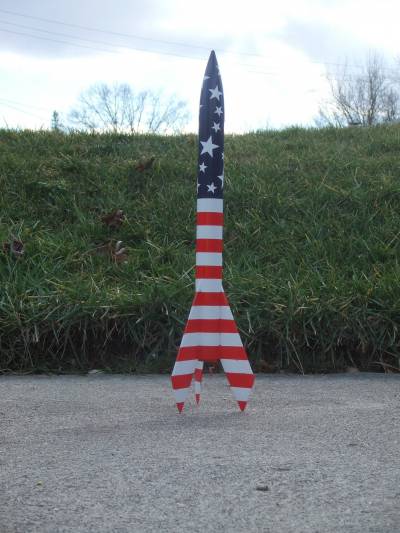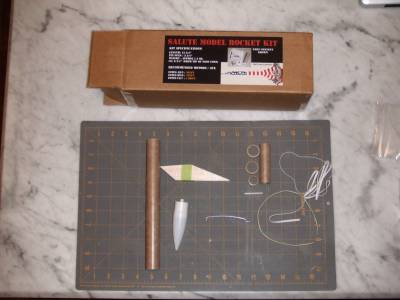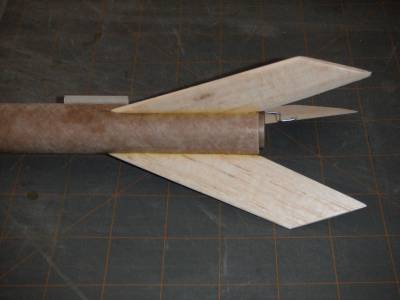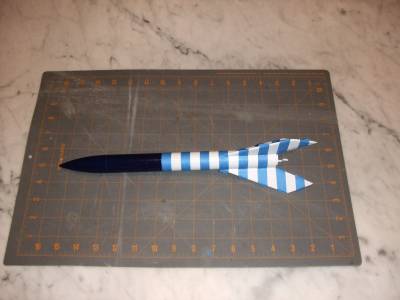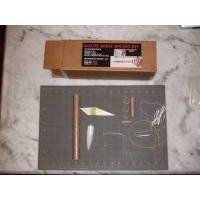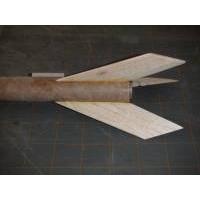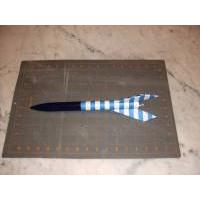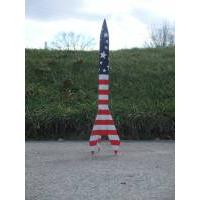Checkered Flag Models Salute
Checkered Flag Models - Salute {Kit} [2012-2015]
Contributed by Chan Stevens
| Construction Rating: | starstarstarstarstar_border |
| Flight Rating: | starstarstarstarstar_border |
| Overall Rating: | starstarstarstarstar_border |
| Published: | 2012-03-05 |
| Diameter: | 0.98 inches |
| Manufacturer: | Checkered Flag Models  |
| Skill Level: | 1 |
| Style: | Sport |
Brief
This is a fairly standard/conventional 3-fin 18mm BT-50-based model, but aimed slightly above the typical quick-build type kit. With excellent documentation, it offers an inexperienced builder the chance to slightly elevate the challenge and develop new skills as well as a better understanding of model rocket construction.
Components
The kit arrived in a very rugged box, with components grouped and bagged into logical subassemblies. Tubes are good quality kraft, nose cone is molded plastic, fins are precut balsa. Parachute is a rugged plastic, the type you'd find lining outdoor tables. My initial impressions, as I opened the box and looked over the parts, are that this is so good as to almost be overkill for newbie modelers, and I mean that as a compliment, not as a critique.
Construction
The instructions and construction notes are by far the strongest and most distinctive aspect of this kit. This is my first Checkered Flag kit, so I've now built models designed by over 60 manufacturers. Of that group, I'd have to say the documentation is among the top 5. The packet consists of about 14 black & white letter-sized pages, professionally illustrated. The font is a bit small which is about the "worst" I can say about these. My kit, while not exactly a "beta", was definitely an early model, and through feedback with Greg a couple of minor enhancements have been incorporated into subsequent versions.
Building the rocket is typical of a 3FNC project, quick and fairly easy. The overall skill level is a 1. The motor mount is a BT-20, metal hook, motor block (ring), and a pair of 20/50 centering rings. As an example of the attention to detail in the documentation, aimed at teaching newbies sound building skills, there are tips to keep glue to a minimum on the motor block (avoids globs that could prevent the motor from sliding all the way in and fillets around the centering rings. The shock cord is composed of Kevlar (lower) and elastic (upper), and the Kevlar is anchored to the motor tube by slipping under the forward 20/50 ring and looping around the motor hook. The elastic is intended to be tied to a loop in the Kevlar, but I personally prefer the simpler approach of pairing the ends and tying a single overhand knott out of the pair (as described in most Quest kits). I'm just paranoid that the Kevlar can be too sharp and tear through the elastic when the elastic is just tied to a loop.
My kit included a good newbie tip regarding zippers, though a little over the top. It warned that the Kevlar should not extend out past the end of the body tube, just the elastic. That's a good design principle. Rather than explain that Kevlar could tear into the end of the tube during deployment, leading to an annoying but repairable zipper, the instructions warn that exposed Kevlar will "destroy" the model when the chute's deployed. I applaud the effort to teach newbies, but don't think we should terrorize them, and I think this area's been toned down now. Besides, the very carefully thought out design winds up keeping the Kevlar/elastic joint inside the tube if you follow the instructions anyway.
Marking the body tube for fin and lug placement is done via a wrap-around template. My template had a minor scaling error resulting in one of the fin lines being about 1mm off from perfect 120-degree orientation, plus the template sheet included a tri-fold shock cord mount that's not used in the construction. Both of these issues have been cleared up in current kits.
The precut fins get a little work before bonding--sanding rounded leading edges, chisel/beveled trailing edges, and surface sanding. The instructions are detailed enough to get down to recommending 220 grit paper, and includes a neat tip to use 2-sided tape to tack all 3 fins together when sanging the edges to true up any minor differences in individual dimensions. Most 3FNC jobs involve fins that you can just look at and immediately know which edge is root, trailing, leading etc., but this design's just slightly unusual enough that you probably need to look at the template and make sure you know which edge is root. If you guess wrong, it won't affect the stability, just won't look quite as nice.
The launch lug is attached slightly forward of the fins, and here I'll offer up one tiny quibble with the design details. If pursuing the "advanced" finishing option, you'll be masking and painting a bunch of 1/2" stripes along the body tube. No matter where you place the lug, this is going to result in at least part of the lug spanning a masking line. Masking a straight line over and around a lug is a pain. I'd recommend splitting the launch lug up into two pieces, each about 3/8" long, and placing them in zones that would be wholly inside a particular stripe. Given that the stripes start 3" from the forward end and alternate every 1/2", it shouldn't be too challenging to mark the stripe zones and place the lug pieces within those zones.
After construction is complete, the instructions get into some very good and detailed finishing guidelines. Examples of tips included are using putty and a rounded craft stick for smoothing/filling fin fillets and masking the INSIDE of the launch lug to keep it from gunking up enough to be too snug on the rod.
Finishing
The suggested paint scheme for this is a red/white/blue concept, though more of a flag-like inspiration. For a simple finish, you could prime then hit it with a couple gloss white base coats, following up by going dark blue for the top section and red for the base/fins. A more challenging scheme is offered in the instructions--blue forward end, followed by alternating red/white stripes down to and through the fins. Purists and flag zealots will have to forgive the blown scale factor that results in 12 stripes down the tube plus 3.5 more down the sweeping lengths of fins, versus the 13 stripes on our flag. Besides, there won't be enough room in the blue area to fit 50 different stars, and while I didn't count, the included peel n' stick white star decals have more than enough to decorate 3-4 rockets.
I went with the stripe scheme, and probably spent at least as much time masking/painting as I spent building the model. On the one hand, these are good skills to develop for the inexperienced builder, but on the other I wouldn't have been too bothered to work with something like water-slide red striping to apply and trim to fit....
Flight
Recommended motors for this 18mm model are A8-3, B6-6 and C6-7. I was feeling a bit lazy on a breezy winter day, so opted for a B6-4 hoping to avoid a long recovery walk. The flight was straight and stable, slight weathercocking. I had gone with a -4 delay thinking the recommended -6 might be a bit long (plus I have way more medium delays than long delays). The 4 was slightly early, though a 6 would have been slightly late, so neither one is much better/worse than the other.
Recovery
The 12" chute is a good size for this, and the heavier/more rugged plastic than that used in most other commercial kits seemed to bring it down a little faster than a more common chute. For this model, I think that's a good thing, as it's small, light, and especially on a C could catch some thermal lift and really drift away. This chute is less likely to hang on a thermal, improving the odds that you'll be able to get this back.
Summary
In general, I think this is a very impressive kit if you're looking for something to help raise the skill level a bit in an inexperienced builder. Yes, it's a basic 3FNC design, putting it in a field crowded with thousands of other options. At $13.95 retail, this kit is priced slightly above the low end of the market, just about in the median range. For that money, though, you get some features that surprised me as almost too good for this kit/niche--very good quality parts, ruggedly packed such that even Fed-Ex's famously former delivery person couldn't damage it , and exceptionally thorough and thoughtful documentation. For their first rocket kit offering, I think Checkered Flag has done a great job on this and I look forward to seeing what else they roll out in the future.
Sponsored Ads
 |
 |
